size:205mm×160mm×62mm 440ページ
<作品の説明>
徳島県産の伝統的素材をいろいろ使って4冊の和本とそれを収める帙を製作。
①和本(深藍):阿波正藍染。染める、絞る、干す、の工程を何度も繰り返し、発酵建て法によって天然藍で染められた深い色調の藍染。(岡本織布工場 藍布屋製)
②和本(梅紫):阿波しじら織。シボを出す独特の風合いと美しさが魅力。さらりと肌触りがよく、軽くて涼しい。濃い色から薄い色へ変化をつけた伝統柄の縞文様は魚のカツオの背から腹の体の色に似ており「鰹縞」(かつおしま)と呼ばれる。(長尾織布製)
③和本(柳緑):表紙は揉み染め阿波和紙、題籤は淡路島産玉葱の皮を漉き込んだベジタブル和紙。手漉きならではの肌触りと、薄くても水に強くて破れにくい丈夫な紙質が特徴(アワガミファクトリー製)
④和本(藍四方染め):徳島県指定無形文化財の蒅藍阿波和紙。耐水効果を持たせるため一枚ずつ「こんにゃく引き」をし、天然藍で手染めした楮・三椏の和紙(アワガミファクトリー製)
全和本のかがりは藍染の糸(徳島県ひまわり園製作)、本文はOA和紙を使用
⑤ケース:
外クロス:(萱草色)落語家古今亭志ん輔高座用本染め手拭い
内クロス:(紺碧)徳島県在住作家、消っしーほりえの『阿波のエラヤッチャン印』手拭い
和本の内容は、国立国会図書館デジタルアーカイブズ等からから引用した『東京名物百人一首』とその翻刻本である。『東京名物百人一首』は明治時代にトレンドだった東京の名産・名店などを短歌で紹介した、百人一首のパロデイ本で、全ページにカラーの挿絵があり、めくっていて楽しい一冊である。
『東京名物百人一首』本文引用元サイト
https://dl.ndl.go.jp/pid/2533447
AWAがいっぱい入った詰め合わせをお楽しみください。
Four Wahon (books bound using traditional Japanese binding) and this storage box were produced using various materials from Awa Province, modern day Tokushima Prefecture. These Japanese books include the Tokyo Meibutsu Hyakunin Isshu and its reprints, which were taken from the Digital Archives of the National Diet Library and other sources. Tokyo Meibutsu Hyakunin Isshu is a parody of the Hyakunin Isshu, a set of 100 poems introducing the famous products and shops of Tokyo that were popular in the Meiji era, depicting colorful illustrations on every page.
(i) Deep indigo coloured Wahon (made using “Awa Ai” dye). The indigo colour was achieved by using natural fermented indigo in a process of dyeing, wringing and drying the fabric many times over (Okamoto Textile Factory, Ranpu-ya).
(ii) Plum purple coloured Wahon (made with Awa shijira weaving). Its unique texture creates beauty through its crinkles. The book is light and cool to the touch, and the traditional “bonito stripe” pattern changes from lighter to darker colours. (Nagao Orifu)
(iii) Willow green coloured Wahon. The cover is made from dyed and rubbed Awa washi paper, the books’ title is made with vegetable washi paper from onion peels from Awaji Island. Awa washi is characterised by its unique handmade texture, and its thin but durable paper has water-resistant and tear-resistant properties (Awagami Factory)
(iv) Wahon (made with indigo-dyed Awa washi paper. Each sheet of washi paper is made using a method of applying glue from the konjac plant to make it water-resistant. It is then hand-dyed with natural indigo (Awagami Factory)
.The binding threads of both books are made from indigo-dyed threads (Himawarien, Tokushima Prefecture) and the text is made of OA Washi paper.
(v) Storage box:
The orange outer part of the box is made from a hon-dyed hand towel … from Shinsuke Kokontei, a Japanese Rakugo story teller.
The azure blue inside is features a hand towel with the “Awa no Erayachan” design made by Kesshi Horie, a resident of Tokushima Prefecture.
<エピソード、制作時の事等>
徳島県は、海あり、山あり、川ありの大自然に囲まれ、その恩恵を受けながら農業や伝統工芸等モノづくりも長く、広く息づいており、日本の原風景が残る場所である。今回の作品は、それぞれの分野の職人が創った徳島県ならではの素材を、和本の材料として仕上げた作品である。
これまで古書の本文(ほんもん)を利用して表紙を装丁しなおすことが多かったが、今回初めて本文から自分で作ってみた。インターネット掲載の電子画像データ情報を、実際に本の形にし、手に取ってページを一枚一枚めくるのは、これまでの装丁とは違った楽しさがあった。また、自分のパソコン知識もソフトも決して最新ではない状況で、自分の力の範囲内で本という形に出来たことに充実感も得られた。なお、本文の『東京名物百人一首』の100番目に紹介されている人類学者・考古学者坪井正五郎博士は、徳島県出身の人類学者鳥居龍蔵の師匠であったのも、阿波との縁である。
『東京名物百人一首』本文引用元サイト
https://dl.ndl.go.jp/pid/2533447
Tokushima Prefecture is surrounded by nature, with its plenty oceans, rivers and mountains, have all played a part in developing Tokushima’s industries. It has long been a hub for agriculture, traditional crafts, and various forms of manufacturing, all which have thrived from the region’s natural areas. The materials used in the collection of Wahon books were all made from materials unique to Tokushima.
In the past, I have often given old books a second life by repairing them. However, this is the first time I’ve made and bound a book scratch, taking images and text from online databases.It was a completely different kind of fun being able to actually hold the book in my hands and turn the individual pages, as opposed to viewing said images on the internet. I also gained a sense of fulfilment from the fact that I was able to create a book within my own abilities, even though my knowledge of computers and software are not quite “up-to-date”.
It was also something of a coincidence that the archaeologist Dr Shogoro Tsuboi, who is introduced as the 100th famous person in these books, was the teacher of the anthropologist Ryuzo Torii from Tokushima Prefecture.
Website from which the text is quoted
https://dl.ndl.go.jp/pid/2533447
<自己紹介>
古書店巡りで気に入った古本を購入しているうちに、傷んだ本を自分で修理したくなり製本の勉強を始めました。これまで会社員として「士農工商」の「商」の人生の中、製本を通じて「工」の面白さに目覚めました。自分好みのデザインや素材を使って修理して愛蔵書に変身させるわくわく感を楽しむ一方、1ミリの違いで仕上がりが大きく変わる「工」の世界で、日々自分の仕事に対する向き合い方と重ね合わせながら反省しつつ自己鍛錬しています。
I started studying bookbinding because I wanted to repair the books I purchased from old bookstores. Traditionally, Japan had been categorised by four distinct social classes, these being Warriors, Farmers, Craftsmen and Merchants. As I have been working as a company employee for a long time, I have been living my life under the “Merchant” class. However, since getting into bookbinding, it has introduced me to a whole new world. In this world, something like a single millimeter of difference can make a huge difference in a finished product, and because of this I have reflected my own approach to every day work, to line up with a craftsman way of thinking, as I continue to learn the art of bookbinding.
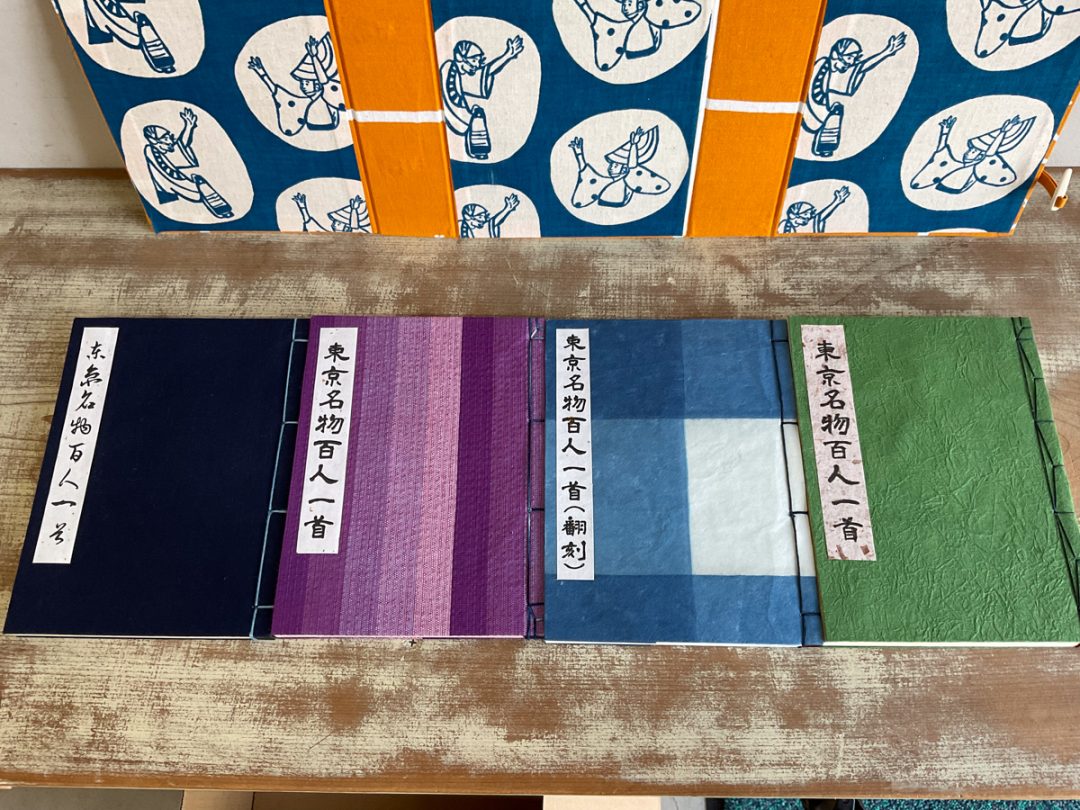
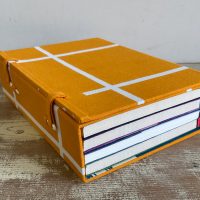
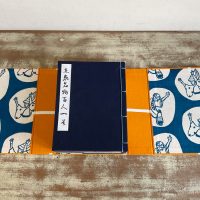
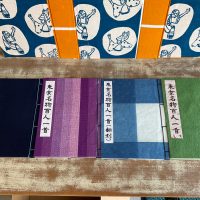

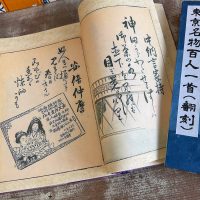
「阿波三昧」阿波に於いて意匠、材料、素材、等々全てが阿波産で将に芸術作品です。
作家が阿波在住で如何に阿波を愛して居るか理解できます。素晴らしい作品を拝見有難うございました。精魂込め心温が温まります。
「阿波三昧」の製本には徳島、淡路の特産の紙、糸、藍染めを使われている。
これだけ地方のもので上手く製本されている。珍しく貴重なものである。将来は特別記念品として保存されるべきものとである。作成者の将来を期待する。
素晴らしい作品の数々を目にして、製本の世界に心が暖かくなる感覚を覚えました。
全くの素人ですので、難しいことは解りませんが、こちらの“阿波三昧”の作品に、自身のこんな心の声が聞こえました。
あちこちに徳島愛が一杯!
一冊ずつを手にとってみたら、それぞれどんな肌触りなのだろう、どれ程深い色合いなのだろう、その奧に広がる世界にその『扉』を開いてみたい。
静寂を感じる本達とは趣が異なり、ケース内クロスの踊り手達からはお囃子が聞こえてきそうです。
4冊それぞれ特性を生かした染め方で、時間をかけて丹念に仕上げられている様子が伺えました。淡路島の玉葱の皮を漉き込んだベジタブル和紙も素敵です。ケースも趣向が凝らされていて、実際に手に取ってみたいと思いました。東京名物百人一首という中身を阿波で仕上げた渾身の作品と感じました。
色と染め、繊維と言の葉、人の想いと伝統技術、それらの織りなす美しい作品とお見受けしました。日本に生まれ、伝わる美と技を普段の生活の中に取り入れたいと思っております。制作者さまの郷土を想う気持ちも伝わって来ます。阿波踊り万歳!
昔の浄瑠璃唄本を思い出した。こういう和綴じはやっぱり素敵です。
古い書物のデジタルアーカイブを使って、いまを生きる伝統技術の染めや和紙。
人の営みが時代を超えて、いや、昔と今が縦横の糸となって織りなしたような、意思を感じる作品だ。
作者の郷土愛も一貫していて気持ちが良い。
本文から作成すること、阿波や淡路の伝統工芸を盛り込むアイデアが素晴らしく、作者の心の豊かさがにじみ出る作品です。
これを機会に阿波の藍染めや和紙をもっと知りたくなりました。貴重な機会をくれてありがとう。
難しい事は分かりませんが…ケースと4冊の本を見て色のバランスがとても良いと思いました
和の色って見ていてとても心が落ち着きますね💕
阿波三昧とある様に阿波の素材にこだわった作者の阿波への想いに愛情深いものを感じます
ケースに使われている阿波踊りのイラストにほっこり癒されます😊
素敵です🙆♀️
阿波の色んな思いがたくさん詰まった作品に出会えることができ心が踊る感じになりました。
ヒロシさん、早速ウエブで作品をご覧いただき有難うございます。そのうち機会がありましたら、実物も手に取ってみて頂ければと思います。
和の雰囲気がとても繊細で素敵!
見ているだけで雅な気持ちになれました。
ケースの内クロスに阿波踊りの手拭いをを使っているのがとても素敵です。和本の落ち着いた深みのある色合いとのコントラストぎ効いていて、阿波の人々の普段の生活と踊りの時の熱量を表現しているのかなと思いました。
阿波の和紙、どれも素敵ですね。それぞれ手に取って肌触りを確かめたくなりました。
阿波踊りの手拭いも楽しいです。ケースを開けたときのワクワク感が伝わってきます。
ネットで拝見するだけなのは残念…と思いながら、手触りを想像し、手に取った時の重さを想像しています。
色のバランスの美しさ、ユーモアのセンス、丁寧な仕上げ、何よりも郷土愛に感銘を受けました。
これからも素敵な作品を生んでください。ご活躍を祈ります。